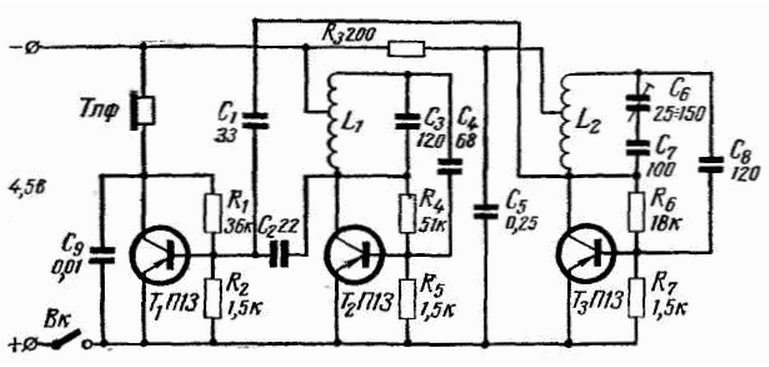
|
|
ENCYCLOPEDIA OF RADIO ELECTRONICS AND ELECTRICAL ENGINEERING A simple metal detector. Encyclopedia of radio electronics and electrical engineering
Encyclopedia of radio electronics and electrical engineering / metal detectors The described metal detector is somewhat inferior in its capabilities to similar devices, but it is simpler in design. They can, for example, detect a five-kopeck coin in the ground at a depth of about 2 cm, and larger objects at a depth of several tens of centimeters.
The metal detector consists of two HF generators assembled on transistors T2 and T3, and a detector-amplifier on transistor T1. Headphones serve as indicators. As an oscillating circuit L1C3, you can use any of the commercially available IF circuits (at 465 kHz) with a tap from part of the turns (for example, from a Ural-57 radio). You can use the entire filter assembly with the screen, or you can remove only the armored core with the coil and attach it directly to the circuit board of the metal detector. Screening is not necessary. The winding of the inductor L2 is wound with 0,38 PEL wire on a wooden or plastic ring with a diameter of 250 mm and contains 31 turns (tap from the 10th turn at the top according to the diagram). Capacitor C6 - ceramic KPK-3. You can take a capacitor of smaller capacity, but then during setup you will have to connect a constant capacitor in parallel with it. Capacitors C5 and C9 are paper (for example, MBM, BM). The remaining capacitors are ceramic or mica. Resistors can be any, including ULM. The power source is a battery for a flashlight (KVS-L-0,5). Instead of P13 transistors, you can use P14-P16 with about 30 V. When the metal detector coil approaches a metal object, the frequency of the generator on transistor T3 changes. The frequency of the other generator (T2) remains the same. As a result, the frequency of the beats played by the phone changes. The ring frame of the L2 coil is attached to a wooden block 40 mm wide, 15 mm thick. Its length is chosen such that it is possible to examine the ground surface without bending over. The lower part of the block has a trapezoidal cutout, into which the metal detector frame with the L2 coil wound on it is placed. A wooden wedge, pre-lubricated with wood glue, is tightly inserted into the cutout. It is necessary to pay special attention to ensure that the frame is firmly fixed to the holder bar. Otherwise, small movements of the frame relative to the bar will lead to an additional (false) change in the beat tone. At a distance of 200-300 mm from the frame, a capacitor C6 is attached to the narrow side of the holder bar. The circuit board is attached to the other side, and the power switch is also located here. The battery is placed on the lower wide side of the holder. The current consumed from the battery does not exceed 4 mA. The terminals connecting the metal detector frame to the circuit board are made of the same wire with which the frame is wound. There is no need to shield the metal detector. If, after assembling the metal detector and turning it on, by rotating the rotor of capacitor C6 it is not possible to ensure that beats are heard in the phones, the frequency of which would change as the rotor is turned, then you can increase the capacitance of capacitor C7 to 200 pF. If after this you cannot hear a beating tone, you should short-circuit capacitor C7. Having heard the beating tone, it is necessary to ensure that the appearance of the tone corresponds to the middle of the range of changes in the capacitance of capacitor C6; this is achieved by more carefully selecting the capacitance of capacitor C7. The metal detector should be used like this: put on your headphones and turn on the power. By rotating the axis of capacitor C6, you should, bringing the metal detector frame closer to the ground surface, to achieve the lowest possible beat tone. After this, the frame is moved parallel to the surface. As the frequency increases, the frame begins to be slowly moved over the place where the frequency increase is observed in order to more accurately determine the location of the metal. In this case, a short-term increase in frequency clearly stands out against the background of a monotonous sound. When searching for small objects, it is better to move the frame not parallel to the surface, but to place its side surface close to the ground. Wet soil, unlike metal, lowers the beat tone, so when the soil moisture changes, it may be necessary to adjust the capacitance of capacitor C6 during the search process. Author: B.Zalivadny
Artificial leather for touch emulation
15.04.2024 Petgugu Global cat litter
15.04.2024 The attractiveness of caring men
14.04.2024
▪ Laser Air Defense System Light Shield ▪ Aircraft powered by lithium polymer batteries ▪ Li-ion battery with water instead of electrolyte
▪ section of the site for the Builder, home craftsman. Selection of articles ▪ article Master the pen. Popular expression ▪ article Locksmith dismantling and assembly work. Standard instruction on labor protection ▪ article General information on toilet soaps. Simple recipes and tips ▪ article Phase power regulator. Encyclopedia of radio electronics and electrical engineering
Home page | Library | Articles | Website map | Site Reviews www.diagram.com.ua |






 Arabic
Arabic Bengali
Bengali Chinese
Chinese English
English French
French German
German Hebrew
Hebrew Hindi
Hindi Italian
Italian Japanese
Japanese Korean
Korean Malay
Malay Polish
Polish Portuguese
Portuguese Spanish
Spanish Turkish
Turkish Ukrainian
Ukrainian Vietnamese
Vietnamese

 Leave your comment on this article:
Leave your comment on this article: